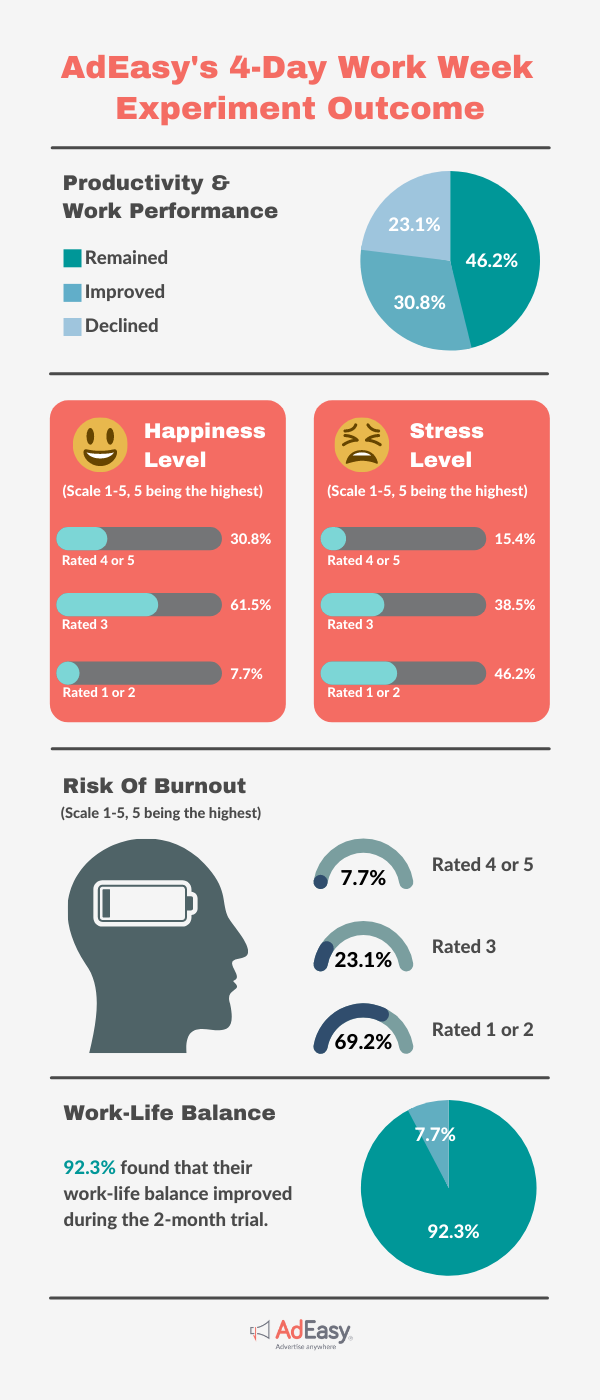4-day work week in Malaysia: a mere pipe dream or a realistic ambition? Team AdEasy piloted this alternative work schedule recently, and here are the results.
How It All Began
As we continue to live and thrive in a post-pandemic world, Covid-19 is also reshaping the future of work. The evolving work environment and expectations have forced companies to rethink their workplace strategies. Hybrid work arrangements are becoming the norm. In-person meetings are replaced with Google Meet and Zoom calls. Job interviews and employee onboarding are conducted virtually. In short, the pandemic has hit the reset button on work trends we are accustomed to.
A few months ago, I came across this article that shared positive results of the 4-day work week trial at the Reykjavik City Council in Iceland. Their employees experienced an improvement on their health and work-life balance, as well as felt less stressed and at risk of burnout.
Being in the second year of the pandemic, and under strict lockdown has affected many of us, not only economically but also mentally mostly due to feelings of isolation from continuously working from home, fatigue from video calls, and stress from the overall pandemic situation. This inspired me to try out the 4-day work week concept at AdEasy, with the purpose of improving the team’s mental wellbeing. Here at AdEasy, we always put our people first. So, when I brought this up to Melissa, my co-founder and CEO, she was immediately onboard.
From Planning To Implementation
The AdEasy executive team started to lay the groundwork for our 4-day work week experiment in mid-July. We researched and read up on how other companies around the world conducted their 4-day work week, then came up with a structure that is relevant to AdEasy - taking into consideration the nature of our business, and the different functions of each team. We decided to run the experiment for two months, from August to September 2021.
Each team had their own goals for success, which would be reviewed at the end of the experiment. The review would take into account the teams’ productivity (output quality and quantity) compared to the previous period, and the overall wellbeing of the team i.e. happiness level, stress level, and risk of burnout level. The designated off days were Mondays and Fridays (to give the team a “longer” weekend). An extra hour of work is added to every working day, and 50% of each team is required to be at work during the off days to ensure operations continue as usual. The team’s salary remained the same.
The Experiment Results
Now, the moment you have been waiting for: the end result of our 2-month trial. Was our 4-day work week experiment a success or flop? I am happy to share that the overall results are positive. Productivity and work performance levels were either the same or increased for most teams.
The general consensus is that having an additional day off resulted in reduced stress and lower risk of experiencing burnout. A 3-day weekend has enabled the team to take a proper break and also spend time managing their personal matters and errands. The majority of the team has also seen significant improvement in their work-life balance.
However, some reported that they felt the week’s pace became faster, and it made them feel like they were rushing to clear their workload. For teams that deal with external parties, they find no difference between a 4-day or 5-day work week as they were on standby during their off days to accommodate those who are working a 5-day work week.
Will AdEasy Implement The 4-Day Work Week Permanently?
84.6% of the team supported the idea of making the 4-day work week permanent at AdEasy. Although we had overall positive results, the productivity level for some teams were affected mainly due to the nature of their functions. As Q4 is a crucial period for AdEasy to hit key milestones before we close the year, we have decided to pause the experiment for this quarter and focus on ramping up the entire team’s time and efforts to meet our goals. We intend to relook into this in Q1 of 2022, when we have time to adjust and experiment till we arrive at a structure that works for all the teams.
Key Takeaways
There is no one-size-fits-all when it comes to implementing something new, especially when each team’s function is different, and when the rest of the industry we operate in still works on a 5-day week. When we relook into this in 2022, we would need to consider each team’s unique function and if they are required to work closely with external parties, and come up with a tailored (and fair) structure for each team.
Despite a 4-day work week being almost unheard of in Malaysia, I definitely encourage other companies to try. As entrepreneurs, we should always be open to trying out new things that might potentially benefit our companies not just in dollars and cents, but also our people. This concept might not work for all, as the nature of some industries may still require 100% of the workforce for 5 days a week. But if you never try you’ll never know. All it takes is an open mind, and some creativity in coming up with a structure that works for your company.
.png)

